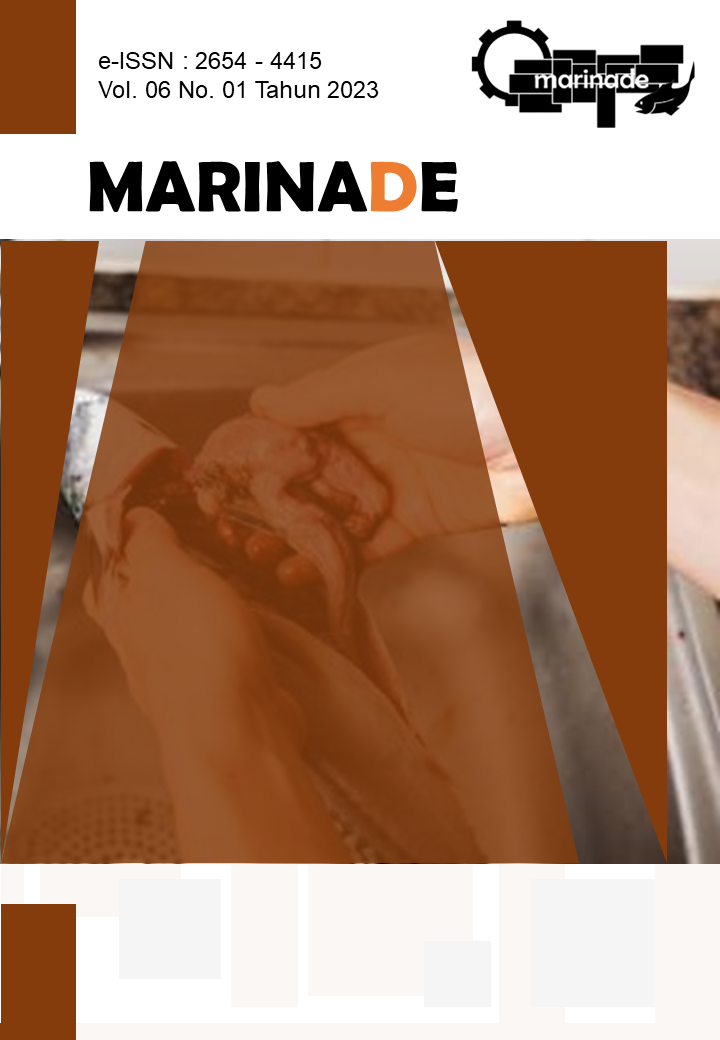PEMBUATAN EDIBLE STRAW DENGAN MEMANFAATKAN WATER RESISTANT SODIUM ALGINATE
DOI:
https://doi.org/10.31629/marinade.v6i01.5491Kata Kunci:
alginat, edible straw, kalsium alginat, sperifikasiAbstrak
Produksi plastik di dunia saat ini sangat besar dan sebagian besar limbah plastik tidak didaur ulang atau dibakar, sehingga menimbulkan masalah lingkungan. Sebagai alternatif, alginat, sebuah polimer yang stabil, dapat digunakan sebagai bahan ramah lingkungan. Tujuan penelitian ini adalah untuk mengevaluasi potensi alginat sebagai pengganti plastik melalui pengujian degradasi alami, tingkat kelarutan air, dan hasil in vitro asam lambung pada edible straw yang dibuat. Hasil yang paling signifikan ditemukan pada pengujian degradasi alami, yaitu semakin tinggi kandungan E.cottonii dalam edible straw, maka straw yang dihasilkan akan semakin lemah. Kedua pengujian lainnya tidak menunjukkan hasil yang signifikan.
Referensi
A’yun, S. N., Triastuti, J., & Saputra, E. (2021). Edible straw formulation from caragenant and gelatin as a solution in reducing plastic waste. In IOP Conference Series: Earth and Environmental Science (Vol. 718, Issue 1, p. 012007). IOP Publishing. https://doi.org/10.1088/1755-1315/718/1/012007
Achmad, Hiskia. 2001. Kimia Unsur dan Radio kimia. Bandung : PT. Citra Aditya Bakti.
Gall, S. , Thompson, R. , 2015. The impact of debris on marine life. Mar. Pollut. Bull. 92 (1-2), 170-179 https://doi.org/10.1016/j.marpolbul.2014.12.041
Haward, M. , 2018. Plastic pollution of the world's seas and oceans as a contempo- rary challenge in ocean governance. Nat. Commun. 9 (1), 667. https://doi.org/10.1038/s41467-018-03104-3
Kong, F., Singh, R. P. 2008, A model Stomach Syste to Investigate Disintegration Kinetics Of Solid Foods During Gastric Digestion. Journal Of Food Science. Vol. 73. https://doi.org/10.1111/j.1750-3841.2008.00745.
Lebreton, L. C. M., van der Zwet, J., Damsteeg, J.-W., Slat, B., Andrady, A., & Reisser, J. (2017). River plastic emissions to the world's oceans. In Nature Communications (Vol. 8, Issue 1). Springer Science and Business Media LLC. https://doi.org/10.1038/ncomms15611
Li, J., Ma, J., Chen, S., He, J., & Huang, Y. (2018). Characterization of calcium alginate/ deacetylated konjac glucomannan blend films prepared by Ca 2+ crosslinking and deacetylation. Food Hydrocolloids, 82, 363-369. https://doi.org/10.1016/j.foodhyd.2018.04.022
North, E.J. , Halden, R.U. , 2013. Plastics and environmental health: the road ahead. Rev. Environ. Health 28 (1), 1-8. https://doi.org/10.1515/reveh-2012-0030
Pang, Y., Xi, F., Luo, J., Liu, G., Guo, T., & Zhang, C. (2018). An alginate film-based degradable triboelectric nanogenerator. RSC Advances, 8(12), 6719-6726. https://doi.org/10.1039/C7RA13294H
Qin, Y., Hu, H., & Luo, A. (2006). The conversion of calcium alginate fibers into alginic acid fibers and sodium alginate fibers. Journal of Applied Polymer Science, 101(6), 4216-4221. https://doi.org/10.1002/app.24524
Rhim, J., W. 2004. Physical and mechanical properties ofwater resistant sodium alginate films.
Journal Lebensm.-Wiss. u.-Technol. 37 (2004) 323-330. https://doi.org/10.1016/j.lwt.2003.09.008
Slezak, R., Krzystek, L., Puchalski, M., Kruci?ska, I., & Sitarski, A. (2023). Degradation of bio-based film plastics in soil under natural conditions. In Science of The Total Environment (Vol. 866, p. 161401). https://doi.org/10.1016/j.scitotenv.2023.161401
Subowo, W. S dan Pujiastuti, S. 2003. Plastik yang terdegradasi secara alami atau biodegradeable terbuat dari LDPE dan pati jagung terlapis, proceeding simposium nasional polimer IV, bandung, pusat penelitian informatika - LIPI, PP.203-208.
Thompson, R.C. , Moore, C.J. , Vom Saal, F.S. , Swan, S.H. , 2009. Plastics, the environtment and human health: current consensus and future trends. Philos. Trans. R. Soc. Lond. B: Biol. Sci. 364 (1526), 2153-2166. https://doi.org/10.1098/rstb.2009.0053
Unduhan
Diterbitkan
Terbitan
Bagian
Lisensi
Hak Cipta (c) 2023 Marinade

Artikel ini berlisensiCreative Commons Attribution-NonCommercial-ShareAlike 4.0 International License.







